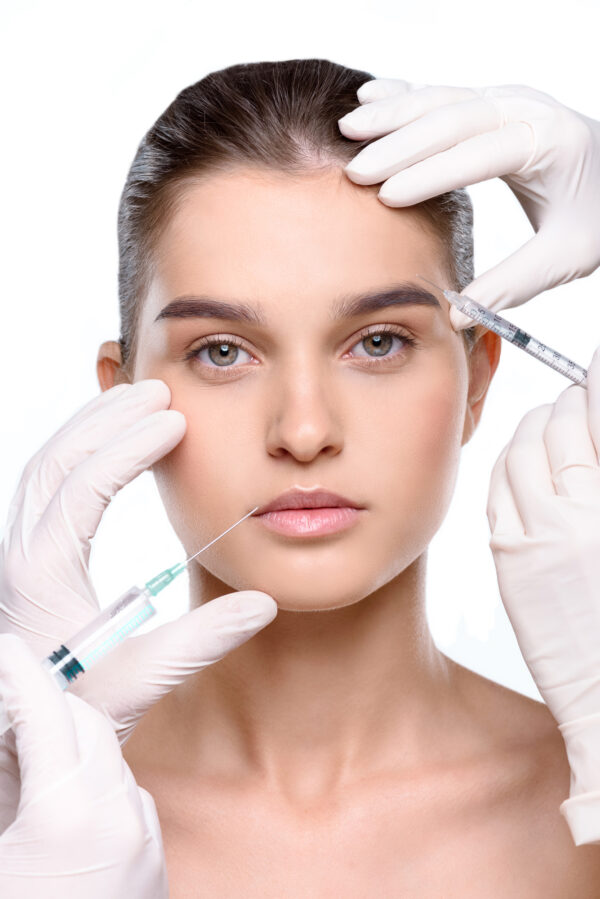
After injecting botulinum toxin A, several facial muscles become paralyzed because the toxin prevents the transmission of vital nerve signals.
For decades, injectables have been the go-to method for wrinkle reduction; in fact, Botox has become widely recognized since that time. There are dermal fillers in addition to Botox that can effectively treat wrinkles through injection. Would dermal fillers or Botox be the better injectables for wrinkles?
Botox and Dermal Fillers: Their Mechanism of Action
Botox and dermal fillers seem to be very similar at first glance; after all, both are injectables used to treat and prevent wrinkles. The way these injectables work, though, is very different. The paralyzing agent botulinum toxin A is the major component of Botox. The toxin blocks the transmission of vital nerve signals, rendering some facial muscles inactive when administered via injection. The outcome is a gradual softening and relaxation of the affected muscles, which in turn delays the onset of wrinkles and fine lines. However, dermal fillers (such as hyaluronic acid, calcium hydroxylapatite (CaHA), poly-L-lactic acid, polymethylmethacrylate (PMMA), etc.) are used to augment the volume of the face’s soft tissues. By boosting specific areas, one can appear younger and more radiant while also reducing the visibility of wrinkles.
Which choice provides the best outcome?
So, we’ve covered the ways Botox and dermal fillers work differently; next, we’ll compare their effectiveness in reducing wrinkles. Both injectables can be just as effective, which is a straightforward but unsatisfying answer. They are different, though, in the amount of time it takes to see results and the duration of those outcomes. The typical time it takes for Botox to take effect is one to two weeks after treatment; however, some people claim to be immune to this effect. The typical duration of a Botox injection is four to six months. To maintain and prolong these benefits, more treatments are needed.
Although the exact duration of dermal filler effects varies from patient to patient and from injection site to injection site, in general, they tend to last longer than Botox’s effects (at least a year). Results from injections typically take around two weeks to become apparent, while some people report seeing an improvement as quickly as a few days after treatment. To maintain the effects of Botox, more treatments are required.
Botox and dermal fillers don’t always produce the same results. Because they stimulate the body’s own collagen and elastin production, dermal fillers often produce more “natural” effects. Botox can produce natural-looking effects, but it also has the potential to cause puffiness and facial stiffness. The ability of the practitioner, the amount and location of the injections, and the patient’s body’s reaction are the determining factors in whether or not the results appear natural.
Possible Adverse Reactions
Botox and dermal fillers both come with the risk of potential adverse effects, as do other cosmetic treatments. Based on their medical history and the medications they take, patients may have a higher likelihood of experiencing certain side effects. Botox and dermal fillers can have both positive and negative effects, so it’s important to talk to your experts about them.
The injection site may bruise, and you may experience drooping eyelids, headaches, and other adverse effects after getting Botox. Patients with weak facial muscles, neuromuscular diseases (such as multiple sclerosis), a history of severe scarring, pregnancy, or nursing should not get Botox or a comparable injection. Dermal fillers can cause a variety of uncomfortable side effects, such as redness, swelling, infection, itching, scarring, blisters, and numbness.
Price Disparities
Because they are considered cosmetic procedures, health insurance companies do not pay for Botox or dermal filler injections. So, for either treatment, patients will need to pay out of their own pockets. The cost of dermal fillers tends to be higher, with prices ranging from $600 to $1,200 for a single treatment. Injections of Botox typically cost around half of that.
The Decision
What about curing wrinkles? Which one is better? How you should proceed is contingent upon your unique needs, objectives, and level of comfort with risk. If all other factors remain constant, Botox provides a less expensive, but (on average) less long-lasting, option for minimizing wrinkles. Although dermal fillers are more expensive, they typically provide longer-lasting and more realistic effects. In order to make the healthiest decision possible, you and your providers should talk about the possible adverse effects of both therapies. Of course, qualified and experienced practitioners should administer these two treatments.
In Dentox, we provide specialized training programs that are meticulously crafted for medical professionals seeking to elevate their expertise in administering Botox and Dermal Filler treatments. For professionals who wish to embark on a transformative journey, please visit https://dentox.com/all-courses/dermal-fillers/ for dermal fillers and https://dentox.com/all-courses/botox-training/ for Botox training. We also provide live courses with real patients at https://dentox.com/live-courses. Medical professionals will experience the exciting opportunities that await them at Dentox, where they can shape a successful career in the ever-evolving field of medical aesthetics.







